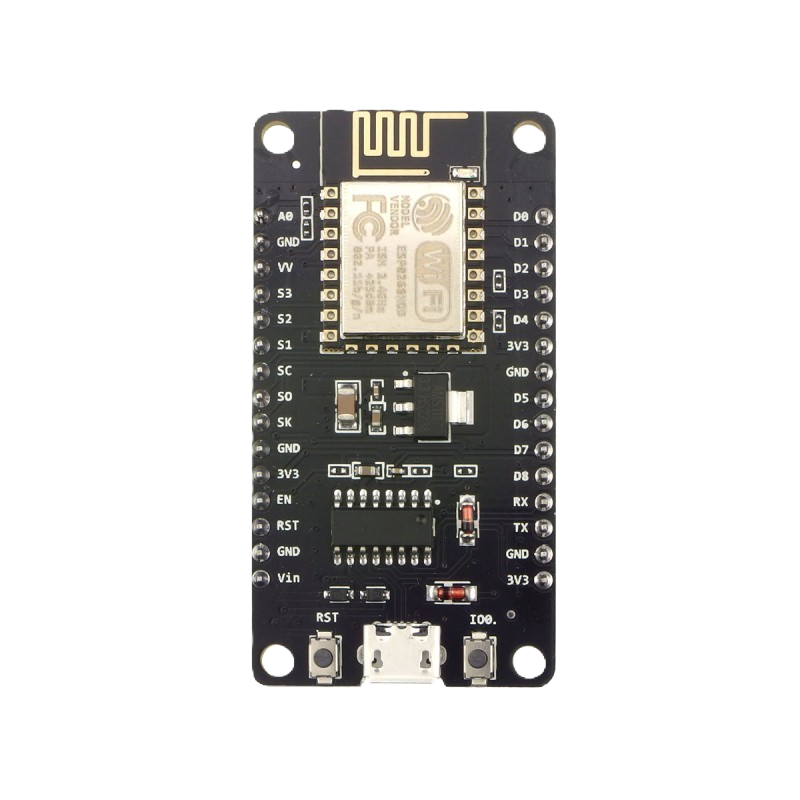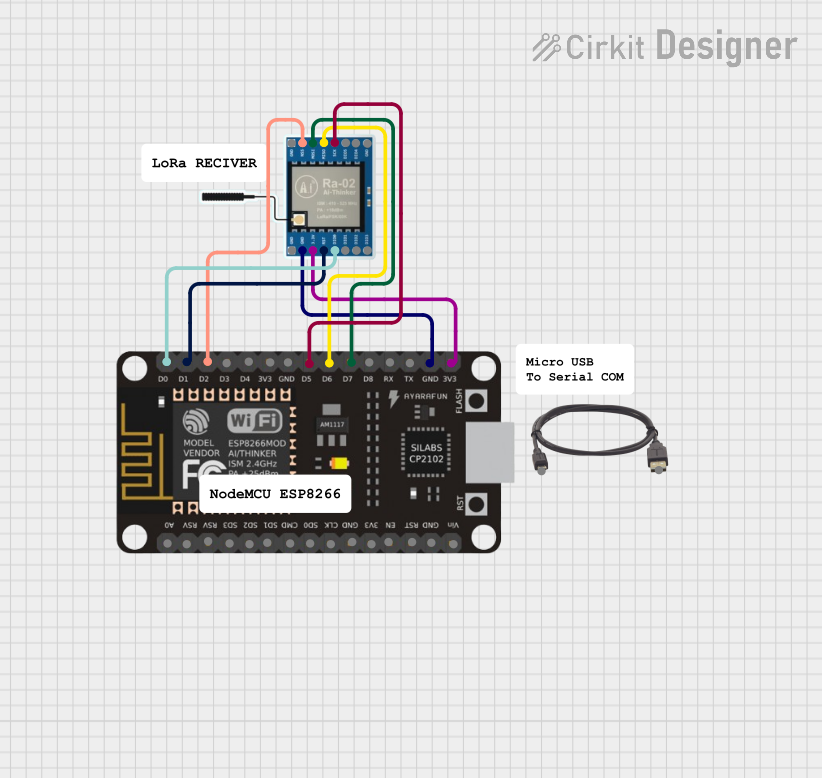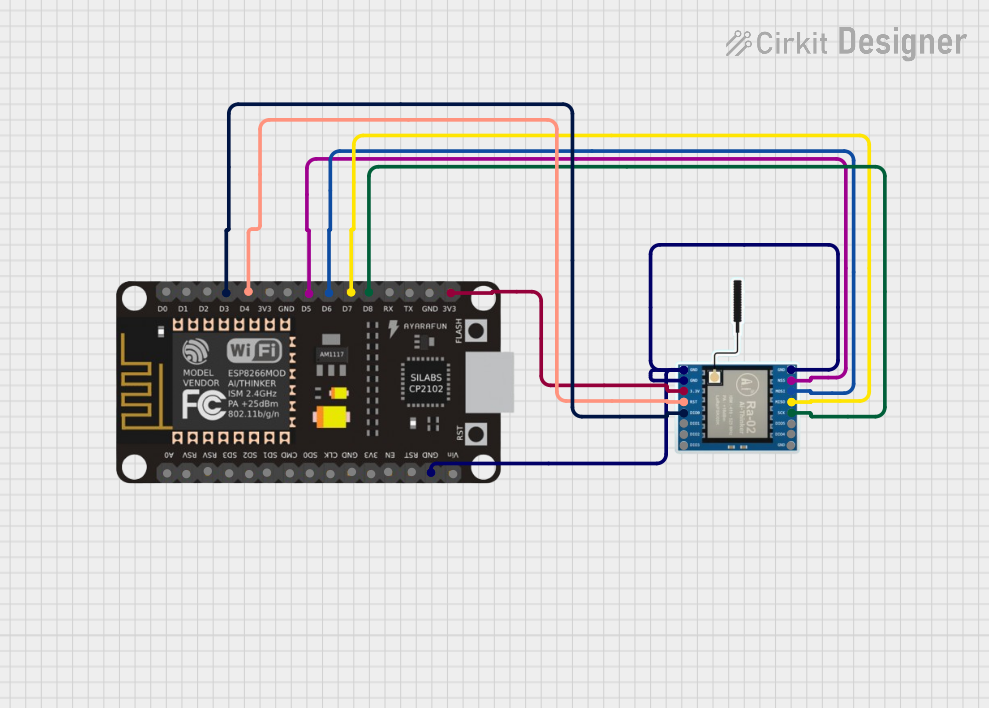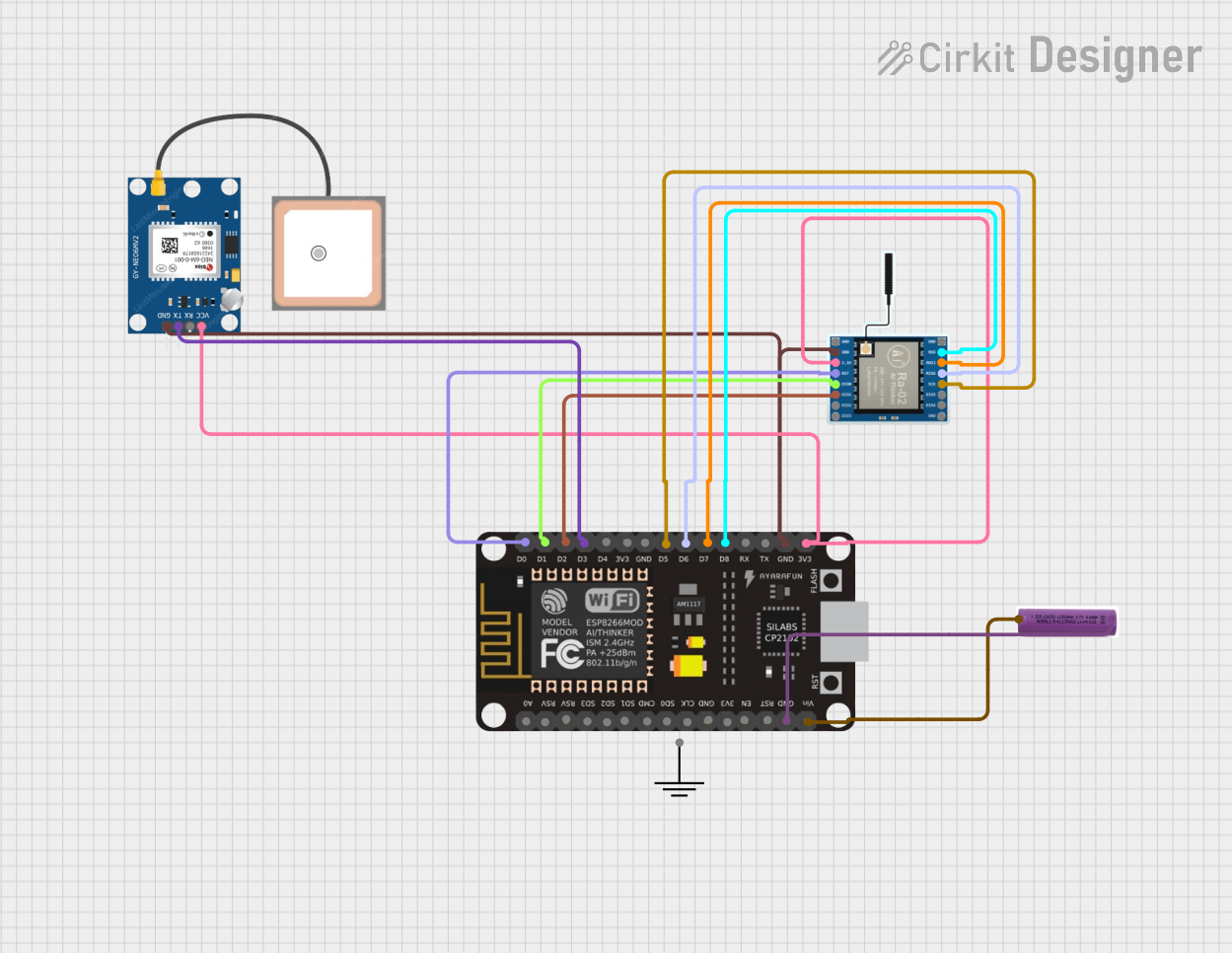
How to Use ESP8266 LoLin NodeMCU V3: Examples, Pinouts, and Specs

 Design with ESP8266 LoLin NodeMCU V3 in Cirkit Designer
Design with ESP8266 LoLin NodeMCU V3 in Cirkit DesignerIntroduction
The ESP8266 LoLin NodeMCU V3 is a low-cost Wi-Fi microcontroller board based on the ESP8266 chip. It features a built-in USB interface for easy programming and a variety of GPIO pins for connecting sensors, actuators, and other devices. This board is widely used in IoT (Internet of Things) applications due to its affordability, compact size, and robust wireless capabilities.
Explore Projects Built with ESP8266 LoLin NodeMCU V3

 Open Project in Cirkit Designer
Open Project in Cirkit Designer
 Open Project in Cirkit Designer
Open Project in Cirkit Designer
 Open Project in Cirkit Designer
Open Project in Cirkit Designer
 Open Project in Cirkit Designer
Open Project in Cirkit DesignerExplore Projects Built with ESP8266 LoLin NodeMCU V3

 Open Project in Cirkit Designer
Open Project in Cirkit Designer
 Open Project in Cirkit Designer
Open Project in Cirkit Designer
 Open Project in Cirkit Designer
Open Project in Cirkit Designer
 Open Project in Cirkit Designer
Open Project in Cirkit DesignerCommon Applications and Use Cases
- Home automation systems
- IoT devices and smart appliances
- Wireless sensor networks
- Remote data logging and monitoring
- Prototyping and educational projects
Technical Specifications
Key Technical Details
- Microcontroller: ESP8266
- Operating Voltage: 3.3V
- Input Voltage (via USB): 5V
- Flash Memory: 4MB
- Wi-Fi Standard: 802.11 b/g/n
- GPIO Pins: 11 (including ADC)
- ADC Resolution: 10-bit
- Clock Speed: 80 MHz (can be overclocked to 160 MHz)
- USB Interface: CH340G USB-to-Serial converter
- Dimensions: 58mm x 31mm x 13mm
Pin Configuration and Descriptions
The ESP8266 LoLin NodeMCU V3 has a total of 30 pins. Below is the pinout description:
| Pin Name | Function | Description |
|---|---|---|
| VIN | Power Input | Accepts 5V input from USB or external power supply. |
| 3V3 | Power Output | Provides 3.3V output for external components. |
| GND | Ground | Common ground for the circuit. |
| D0-D8 | GPIO Pins | General-purpose input/output pins. Can be used for digital I/O or PWM. |
| A0 | Analog Input | 10-bit ADC pin for reading analog signals (0-1V range). |
| RX | UART Receive | Serial data input for UART communication. |
| TX | UART Transmit | Serial data output for UART communication. |
| EN | Enable | Active-high pin to enable the module. |
| RST | Reset | Resets the microcontroller when pulled low. |
| SD3, SD2 | SPI Pins | Used for SPI communication (shared with GPIO). |
| SCL, SDA | I2C Pins | Used for I2C communication (shared with GPIO). |
Usage Instructions
How to Use the ESP8266 LoLin NodeMCU V3 in a Circuit
Powering the Board:
- Connect the board to your computer via a micro-USB cable for power and programming.
- Alternatively, supply 5V to the VIN pin and GND for external power.
Programming the Board:
- Install the Arduino IDE and add the ESP8266 board package via the Board Manager.
- Select "NodeMCU 1.0 (ESP-12E Module)" as the board in the Arduino IDE.
- Connect the board to your computer and select the appropriate COM port.
- Write your code and upload it to the board.
Connecting Sensors and Actuators:
- Use the GPIO pins (D0-D8) for digital input/output or PWM.
- Use the A0 pin for reading analog signals (ensure the input voltage is within 0-1V).
- For I2C devices, connect to the SDA and SCL pins.
- For SPI devices, use the SD3 and SD2 pins.
Important Considerations and Best Practices
- Voltage Levels: The GPIO pins operate at 3.3V. Avoid connecting 5V signals directly to the pins to prevent damage. Use a level shifter if necessary.
- Analog Input Voltage: The A0 pin accepts a maximum of 1V. Use a voltage divider if your sensor outputs higher voltages.
- Wi-Fi Configuration: Ensure your Wi-Fi credentials are correct when programming the board for network connectivity.
- Heat Management: The ESP8266 chip may get warm during operation. Ensure proper ventilation if used in enclosed spaces.
Example Code for Arduino IDE
The following example demonstrates how to connect the ESP8266 LoLin NodeMCU V3 to a Wi-Fi network and control an LED connected to GPIO pin D1.
#include <ESP8266WiFi.h> // Include the ESP8266 Wi-Fi library
// Replace with your Wi-Fi credentials
const char* ssid = "Your_SSID";
const char* password = "Your_PASSWORD";
const int ledPin = D1; // GPIO pin for the LED
void setup() {
Serial.begin(115200); // Initialize serial communication
pinMode(ledPin, OUTPUT); // Set the LED pin as an output
// Connect to Wi-Fi
Serial.print("Connecting to Wi-Fi");
WiFi.begin(ssid, password);
while (WiFi.status() != WL_CONNECTED) {
delay(500);
Serial.print(".");
}
Serial.println("\nWi-Fi connected!");
Serial.print("IP Address: ");
Serial.println(WiFi.localIP()); // Print the device's IP address
}
void loop() {
digitalWrite(ledPin, HIGH); // Turn the LED on
delay(1000); // Wait for 1 second
digitalWrite(ledPin, LOW); // Turn the LED off
delay(1000); // Wait for 1 second
}
Troubleshooting and FAQs
Common Issues and Solutions
The board is not detected by the computer:
- Ensure the USB cable is functional and supports data transfer.
- Install the CH340G USB driver if the board is not recognized.
Wi-Fi connection fails:
- Double-check the SSID and password in your code.
- Ensure the Wi-Fi network is within range and not using unsupported security protocols.
GPIO pins not working as expected:
- Verify the pin mode is correctly set in the code (e.g.,
INPUT,OUTPUT). - Check for conflicting pin assignments in your circuit.
- Verify the pin mode is correctly set in the code (e.g.,
Upload errors in Arduino IDE:
- Ensure the correct board and COM port are selected in the IDE.
- Press and hold the "Flash" button on the board while uploading the code.
FAQs
Can I power the board with a battery?
Yes, you can use a 3.7V LiPo battery connected to the VIN and GND pins. Ensure the battery voltage does not exceed 5V.What is the maximum current the GPIO pins can handle?
Each GPIO pin can source or sink up to 12mA. For higher currents, use an external transistor or relay.Can I use the board without Wi-Fi?
Yes, the ESP8266 can function as a standalone microcontroller for non-Wi-Fi applications.How do I reset the board?
Press the "RST" button on the board or pull the RST pin low momentarily.